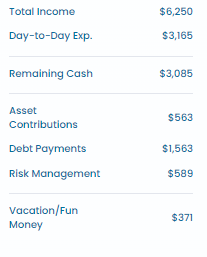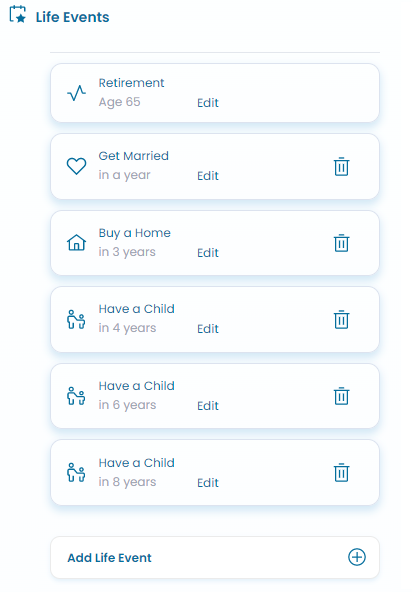Personal Financial Planning Example To Help You Build Your Own Financial Plan
By Joseph Reinke, CFA
In the past, building a comprehensive personal financial plan was difficult. I spent 15 years in the financial services industry researching ways to make personal finance easier. The FitBUX financial planning method discussed below is a culmination of that research. The purpose of it, to make your financial life stress free so you can focus on other areas of your life.
In this article, I will show you a financial planning example with step-by-step instructions so you know how to set up your own financial plan and have peace of mind.
We'll also look at some common mistakes people make when implementing their financial plans so you can avoid them in the future.
As a note before we get started, my research dug deep into behavioral influences on people's financial life in order to figure out why they missed financial goals. Therefore, the financial planning method I'm going to teach you in this article is not just about dollars and cents. It incorporates tried and true methods that you can use to eliminate biases and accomplish your goals.
Personal Financial Planning Example: The Situation
The FitBUX financial planning method may be used by anyone at any age. However, in this financial planning example, I'm going to show a FitBUX member's real-life situation to illustrate how he built a comprehensive financial plan. You can take the same steps when planning your financial future.
His name is Conor. Conor's financial situation and financial goals are listed below:
Just finished his DPT (Doctor of Physical Therapy) making $75k per year.
$100k in student loan debt
Engaged and his Fiance is also a PT making $72k per year with no debt
Getting married in 1 year
Needed to save for an emergency fund
Wants to buy a house in 3 years
They would like to have 3 children
His Fiance wants the ability to choose to stay at home once she has children. In short, she wanted a good financial plan that allowed them to be debt free ASAP and wanted to make good financial decisions to get them there quickly. That was her version of financial stability.
The Mistake Most People Immediately Make On Their Financial Plan
Financial services are segmented. This means there are good people trying to help you but their knowledge is limited. Therefore, they might be able to get you a product but they can't help you decide how it fits in your overall financial plan.
In this financial planning example, I illustrate this problem using Conor's story. However, this happens to all of us everyday when it comes to our money and costs $100,000s over our lifetimes.
The Loan Servicer
Conor's loan servicer recommended that he go onto Revised Pay As You Earn (REPAYE) for his student loans.
Conor didn't realize they had to tell him that by law. In short, loan servicers are not financial experts. What a servicer tells you is not a recommendation but a requirement they must tell you.
The Financial Planner
Instead of going to an expert student loan planner, Conor went to a traditional financial advisor.
Advisors can be great for tax planning, estate needs, and managing retirement savings.
However, most financial advisors do not have a good understanding of items that affect young professionals such as student loans.
Connor's planner admitted to not knowing much about student loans but recommended REPAYE which is not uncommon.
His reasoning for telling Connor to use REPAYE was that it gave him the lowest monthly payment. Therefore, the low monthly payment would allow him to accomplish three of his financial goals "quickly:" Save for his emergency fund, wedding, and then for his house.
Conor then asked this financial advisor how much home he'd be able to afford. The planner recommended a mortgage broker for Conor to speak with because he didn't know much about mortgages.
The mortgage broker Conor meet with told him that he qualified for a $650,000 mortgage. Conor didn't realize this is how much he qualified for, not how much he could afford.
Armed with this information, Conor went back to the financial advisor and paid $2,100 for a financial plan. The plan had him going onto REPAYE, buying a house with a $650,000 mortgage, and having a lot of money going towards his retirement.
The Big Mistake
Most individuals would have started implementing that financial plan without ever simulating various results.
However, Conor used FitBUX to simulate the plan the advisor gave him before implementing it.
Had he followed his advisor's advice, he would have found himself in financial ruin in 15-20 years at age 45-50.
The only way for him to "survive" would be for both him and his fiance to continue working and put off retirement until 73 years old. They would be stuck in the rat race.
Below is a financial planning example showing how Conor used FitBUX's technology and a call with a FitBUX Coach to develop a plan that worked.
Step 1: Organizing Your Money
There are three distinct steps in this financial planning example that I will highlight: Organizing, building/simulating your plan, and implementing it. Doing these steps will make wealth management easy.
We start off with organizing your money correctly.
This means building a budget the correct way.
The incorrect way is what most people do, i.e. they list a bunch of spending items in excel or on an app and have no meaning behind them. Then they stress about over spending on items instead of focusing on the big picture.
To do it correctly, you should budget your money into three categories:
Day-To-Day Money
Money For Future Self
Risk Management
Day-To-Day Money
Day-to-day money consists of two items: Your income and day-to-day expenses.
It does not take into account investments, savings, debt payments, or insurance.
Income consists of all income you receive such as salary, dividends, interest, etc...
Day-to-day expenses consists only of items that you need/incur on a monthly basis.
Spending on items such as rent, food, utilities, gas, clothes, etc should be included.
In our financial planning example, Conor has about 50% of his income going to day-to-day expenses.

Money For Future Self
The second category is money for future self.
This money is used for items such as saving for short-term goals, investing and retirement, and paying off debt.
All these things don't happen over night and take time.
In our personal financial planning example, Conor had about 34% of his money going to this category.
Money To Manage Risk
The third category is one of the most overlooked parts of building a personal financial plan. However, its one of the most important.
Your future goals take time to achieve. What if you don't have time because of disability, death, health care expenses, etc...?
This category focuses on protecting yourself and your financial plan, i.e. risk management.
It consists of money for insurance premiums such has health insurance, life insurance, car insurance, and disability insurance.
In our financial planning example, after completing these steps, Conor had $371 in Vacation/Fun Money left over each month.

Correctly Setting Your Financial Goals
Your financial goals consists of two categories: Big picture and short-term.
Big Picture Financial Goal
Your big picture goal is the primary financial goal you should be focusing on. This is also the part most people get wrong so its extremely important.
Doing it right is key and highlights why you need to budget your money the way I described above.
What you focus on is what you'll continue to have in the future. Most people are focusing their money on day-to-day expenses which means they will get more of that in the future. Its called lifestyle creep.
For example, Conor currently has 50% of his income going to day-to-day expenses and 34% to money for future self.
Most people leave these percentages the same their entire lives even after they get a raise.
What your long-term goal should be is to flip-flop these percentages. In our financial planning example, this means Conor should focus on increasing the 34% of his income going to money for future self to 50% or more. The faster you do this the faster you'll become financially free.
Short-Term Financial Goal
Those that focus become financially free faster. Therefore, you should focus on one short-term goal at a time.
Turning our focus back to our financial planning example, Conor decided to tackle his goals in the following order: Save an emergency fund, save for the wedding, then pay off his student loans, then save for a house, then pay off the mortgage, then save aggressively for retirement.
Therefore, he put what we at FitBUX call minimums towards his investments. This means he put enough in his employer retirement plan to get his employer match and put $50 a month towards his Roth IRA.
Then 100% of his money went to his his first short-term goal which was to focus on his emergency savings. Then after that, he'd save 100% towards his wedding and then keep going as he accomplished each of his goals.
One big mistake is that people and financial advisors try to do too much. Focus on achieving one short-term goal at a time.

Step 2: Simulate The Financial Plan
This is were the majority of financial plans fail.
The key here is to evaluate if your financial plan allows you to meet both your big picture goal and short-term goals.
In our financial planning example, Conor would have failed in the long-term because the financial planner he paid skipped this step.
By using the steps above to set up his financial plan and simulating it using FitBUX's technology, Conor was able to:
Save for a wedding and get married;
See exactly how he could pay off his student loans in 3 years;
Buy a house;
Have 3 kids, and
His wife would have ability to stay at home if she wanted to!
If they followed this plan, by retirement, they'd have between $2.9 and $3.6 million dollars!
Step 3: Implement Your Financial Plan
Your life is not static. Therefore, in order to achieve your goals and stay on track, you must have a way to implement your plan.
There are two keys to implementing your financial plan:
Making it easy; and
Avoiding mistakes most people make.
Making It Easy To Implement
Most people look at absolute dollar amounts which makes life very stressful. For example, they stress about overspending on restaurants. This is wrong!
Instead, look at what percentage of your money went where and compare that to the percentage you set in your financial plan.
In our financial planning example, one of Connor's short-term goals was to put 25% of his total income to student loans each month/year.
At the end of the month, all he has to do is see if he put 25% to loans, if he did great. If not, see why and make sure it doesn't happen again the next month.
He also shouldn't worry about investing or retirement at this point because he has his emergency savings, is achieving his other goals, plus he has the minimums set to his 401k and Roth IRA.
If Connor missed his goal of putting 25% towards his student loans, then he would need to go back and review his budget to see why. If he hit it, then move on and worry about other things in your life besides money.
One item to note. Your plan is not a static document.
However, you shouldn't have to change it often. The only time you need to do anything is if you have a life event like buying a car and need to make a major change to your financial plan or you achieve one of your goals.
Avoiding The Mistake Most People Make
The biggest mistake people make is life style creep. Tracking what percentage of your money is going to which of the three categories we discussed in step 1 helps you avoid this.
In our Financial planning example, Conor had about 34% of his total income going to the 2nd category i.e. future goal money. He had about 50% going to the 1st category, i.e. day-to-day money.
Over time, your biggest financial goal is to switch that. For example, 50% of your money should be going to future goal money and 30% to day-to-day money.
Doing so would mean you are investing in assets at a very rapid pace or quickly paying off high interest debt such as credit card debt. This will accelerate how quickly you achieve financial freedom.
Most don't do this.
Instead, as their income increases life style creep happens and they keep putting 50% towards day-to-day expenses.
This is why we see people who start contributing $100 per month to a Roth IRA ten years ago and today they still are contributing $100. They were focused on absolute dollar amounts and they will never hit their retirement goals.
They should've been focusing on what percentage of their total income is going where.
Conclusion
Overall, financial planning is an important step in achieving financial freedom and peace of mind.
As demonstrated in this financial planning example, understanding and utilizing the three steps of financial planning - setting up a financial plan, simulating it, and implementing it - you can ensure that you are on track to reach your desired outcome.
Furthermore, focusing on what percentage of total income goes where rather than absolute dollar amounts will help avoid life style creep as well as accelerate investments into assets or paying off debt.
We highly recommend using FitBUX’s technology to make sure that all aspects of your own personal financial plan have been taken into account so that you can achieve lasting success!
By Joseph Reinke, CFA
Joseph Reinke is a Chartered Financial Analyst (CFA) Charter Holder and founder of FitBUX which has helped over 14,000 young professionals on their journey to financial freedom. Joseph has been personally investing since he was 12 years old.
In addition, he has experience in student loans, mortgages, wealth management, investment banking, valuation, stock trading, and option trading. He has been on 100s of podcast and has been invited to 100s of universities to discuss financial planning with their soon to be graduates.
Learn More About Joseph